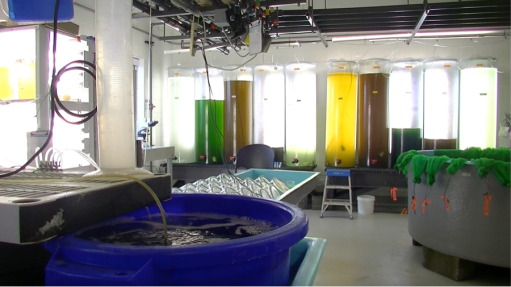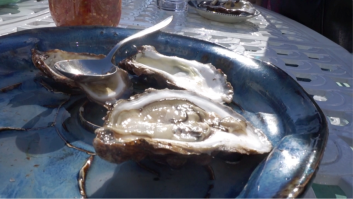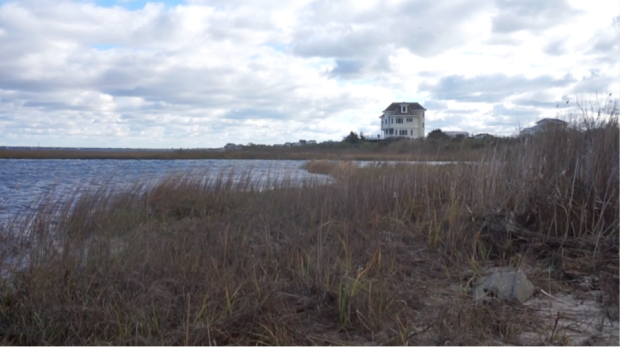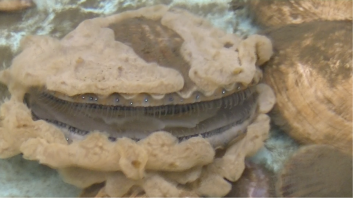December 13, 2015
In a bayside seawater lab on the south shore of Southampton tanks of baby scallops, clams, and oysters tell the story of an increasingly clear reality. The ocean’s waters may no longer be a suitable place for growing shellfish.
Researchers at Stony Brooks School of Marine and Atmospheric Sciences are using clues from developing shellfish to determine how the ocean’s evolving waters will change the types of sea creatures seen beneath the water’s surface. For many of their experiments, the prognosis doesn’t seem good.
“We saw the scallop larvae die immediately,” says Andrew Griffith, a PhD candidate studying ocean acidification. The scallops were grown in a tank of water collected right off the shores of Long Island.

The seawater lab at Stony Brook University
The culprit of such a change is ocean acidification, or a change in the ocean’s water chemistry due to climate change. As the atmosphere becomes increasingly saturated with carbon dioxide the ocean acts as a giant carbon sponge. Some of the extra carbon gets absorbed into the water and disrupts its natural chemistry.
New studies, including Nagelkerken and Connell’s paper published in October, reveal ocean acidification will have broader worldwide impacts than previously predicted. This topic will surely be a hot button issue at the Paris Climate Change Conference this week.
Since the Industrial Revolution the world’s oceans have become 30 percent more acidic and by the end of the century scientists at the National Oceanic and Atmospheric Administration (NOAA) predict the ocean’s acidity will be higher than it has been over the last 20 million years.
But how exactly does this change in ocean chemistry hurt the growing shellfish?
“The initial shell development is crucial for larva,” says Griffith. “If they have to spend more energy in developing the shell t

Oysters from Widow’s Hole Oyster Farm in Greenport, Long Island
hat’s less energy available for other things like reproduction, resisting disease and other environmental stressors.”
Shellfish are soft-bodied creatures that rely on their protective outer shells for survival. These shells are made of calcium carbonate, the same type of material that makes chalk and marble. As the oceans become more acidic the shellfish have a harder time building strong calcium carbonate shells.
“Acidification and shellfish is a problem, that doesn’t mean shellfish can’t overcome them but its being overcome at a cost and we don’t know what that cost is yet,” says Griffith.
Shellfish already have a rocky road ahead without the added threat of ocean acidification. According to The Nature Conservancy, nearly 85 percent of global oyster reefs have been lost. Commercial dredging, overfishing, invasive species, loss of habitat and a decrease in water quality are all contributing factors.
Laura Fabrizio grew up on the shores of Westhampton on Long Island. The changes in the waters surrounding her home prompted her to create the Moriches Bay Project, a non-for profit organization dedicated to reintroducing oysters into the Moriches Bay. She and Aram Terchunian, a coastal geologist and environmental scientist for First Coastal Corporation, co-founded the project.

The view from a Moriches Bay Project site in Westhampton, NY
“The water’s continually become dirtier and dirtier and dirtier, and the fish move away, and the oyster and clam populations have become smaller and smaller,” says Fabrizio.
Oysters specifically play a key role in keeping ocean waters clean. They are the filter systems of the ocean. A mature oyster filters roughly 50 gallons of water a day.
“You’re average swimming pool is about 20,000 gallons. So think a bout that, a thousand oysters filters more than two swimming pools in a single day,” says Terchunian.
Beyond maintaining clean and healthy waters, shellfish also contribute significantly to local economies. The West Coast shellfish industry provides paychecks for over 3,000 people, and supports a $84 million industry.
In the early 2000s the Pacific Oyster hatcheries experienced an alarming plummet in oyster production. By 2008 one oyster farm, Whisky Creek, experienced an 80 percent decrease in oyster landings according to the NOAA.
The unique Pacific coast water circulation patterns called upwelling brings cold and carbon rich water to the surface where shellfish grow, creating a hot spot of ocean acidification.

A sea scallop. Look at those eyes!
On the West Coast they frequently use the term “lazy larva” to describe young shellfish that fail to swim or eat.
“That’s the canary in our coal mine,” says Griffith. Acidic conditions on the West Coast means the Atlantic coast will soon see similar problems.
In Maine, that may already be the case.
A report released this past February by a specific commission tasked with studying possible impacts of ocean acidification on the state deemed the situation an “urgent” matter.
The state is not taking this issue lightly. They have since created four bills that outline a plan to combat ocean acidification including initiating a runoff limit, a $3 million bond to monitor coastal pollution, and a guarantee that the ocean acidification commission would remain for the next three years.
The lobster industry alone accounts for $1 billion, and there is new evidence from Saint Francis Xavier University suggesting acidic conditions impact lobster larva just like they impact shellfish larva.
The Maine shellfish industry will take a hit as well. Bill Mook of Mook Sea Farm noticed problems with his oysters over a decade ago. Since the start of his company nearly 30 years ago the acidity off Maine’s coast has changed by roughly 30 parts per million, enough to significantly hinder shellfish shell growth.
Griffith expects the rest of the Atlantic Coast will soon follow.
“We will see these effects begin to migrate down…Southern New England and long island are next,” says Griffith.
The next challenge may be determining new ways of promoting shell growth despite naturally acidic conditions. Humans may have to intervene to preserve such a critical ocean animal, for our own sake and for the rest of the ocean.
